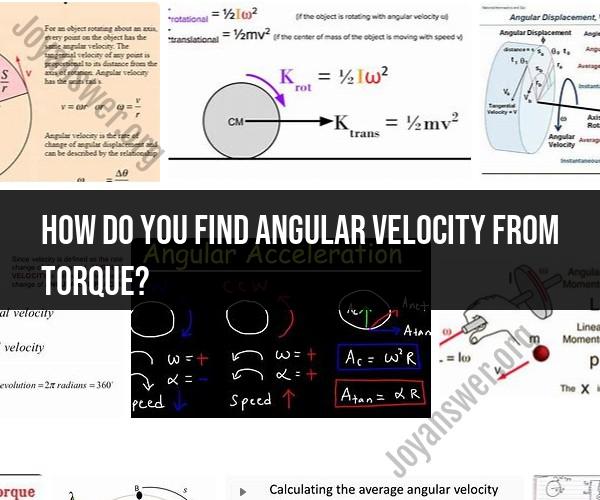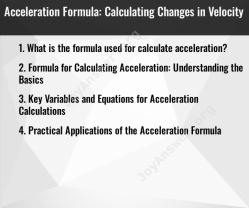How do you find angular velocity from torque?
To find the angular velocity from torque, you can use the rotational analog of Newton's second law, which relates torque (τ), moment of inertia (I), and angular acceleration (α). The formula is as follows:
τ = I * α
Where:
- τ (tau) represents the torque applied to an object.
- I (uppercase "i") is the moment of inertia, which depends on the object's shape and mass distribution.
- α (alpha) is the angular acceleration, which is the change in angular velocity (ω) over time.
If you want to find the angular velocity (ω) resulting from a given torque and moment of inertia, you can rearrange the formula as follows:
ω = (τ / I)
To use this formula to find the angular velocity, follow these steps:
Determine the Torque (τ): Measure or calculate the torque applied to the rotating object. Torque is typically measured in newton-meters (N·m) in the International System of Units (SI).
Find the Moment of Inertia (I): The moment of inertia depends on the object's shape and mass distribution. Different objects have different formulas for moment of inertia. You may need to consult a physics reference or textbook to find the appropriate moment of inertia formula for your specific object. The units of moment of inertia are typically kilogram-meter squared (kg·m²) in SI units.
Calculate Angular Velocity (ω): Plug the values for torque (τ) and moment of inertia (I) into the formula:
ω = (τ / I)
Make sure to use consistent units for torque and moment of inertia. The resulting angular velocity (ω) will be in radians per second (rad/s) because torque and moment of inertia are typically measured in SI units.
This formula allows you to calculate the angular velocity of a rotating object when you know the torque applied to it and its moment of inertia. Angular velocity represents how quickly the object is rotating, and it is usually measured in radians per second.
Finding Angular Velocity from Torque in Rotational Dynamics
Angular velocity can be found from torque using the following equation:
ω = τ / I
where:
- ω is the angular velocity in rad/s
- τ is the torque in N⋅m
- I is the moment of inertia in kg⋅m²
This equation is derived from Newton's second law of motion, which states that the net torque on an object is equal to the product of its moment of inertia and its angular acceleration.
The Relationship Between Torque, Moment of Inertia, and Angular Velocity
Torque, moment of inertia, and angular velocity are all related to each other in rotational dynamics. Torque is the force that tends to cause rotation, moment of inertia is a measure of an object's resistance to rotation, and angular velocity is the rate of change of angular position.
The relationship between torque, moment of inertia, and angular velocity is given by the following equation:
τ = Iω
This equation shows that the torque on an object is proportional to its angular velocity and its moment of inertia.
Mathematical Formulas for Calculating Angular Velocity
The following are some mathematical formulas for calculating angular velocity:
- Constant angular velocity:
ω = θ / t
where:
ω is the angular velocity in rad/s
θ is the angular displacement in radians
t is the time in seconds
Variable angular velocity:
ω = dθ / dt
where:
ω is the angular velocity in rad/s
θ is the angular displacement in radians
t is the time in seconds
Relationship between torque, moment of inertia, and angular velocity:
ω = τ / I
where:
- ω is the angular velocity in rad/s
- τ is the torque in N⋅m
- I is the moment of inertia in kg⋅m²
Real-World Examples of Angular Velocity Determination
Here are some real-world examples of angular velocity determination:
- Measuring the angular velocity of a rotating machine:
The angular velocity of a rotating machine can be measured using a tachometer. A tachometer is a device that measures rotational speed.
- Measuring the angular velocity of a planet:
The angular velocity of a planet orbiting the Sun can be calculated using its distance from the Sun and its mass.
- Measuring the angular velocity of an athlete throwing a ball:
The angular velocity of an athlete throwing a ball can be calculated using the height and distance that the ball travels.
Problem-Solving and Analysis Using Angular Velocity and Torque
Angular velocity and torque can be used to solve a variety of problems in rotational dynamics. For example, these concepts can be used to:
- Design and analyze rotating machines:
Angular velocity and torque are used to design and analyze rotating machines, such as engines, turbines, and generators.
- Study the motion of objects in circular motion:
Angular velocity and torque are used to study the motion of objects in circular motion, such as planets and stars.
- Explain a variety of phenomena in the natural world:
Angular velocity and torque can be used to explain a variety of phenomena in the natural world, such as the precession of the gyroscope and the motion of a spinning top.
Angular velocity and torque are important concepts in physics and engineering. They are used to design and analyze rotating machines, to study the motion of objects in circular motion, and to explain a variety of phenomena in the natural world.












